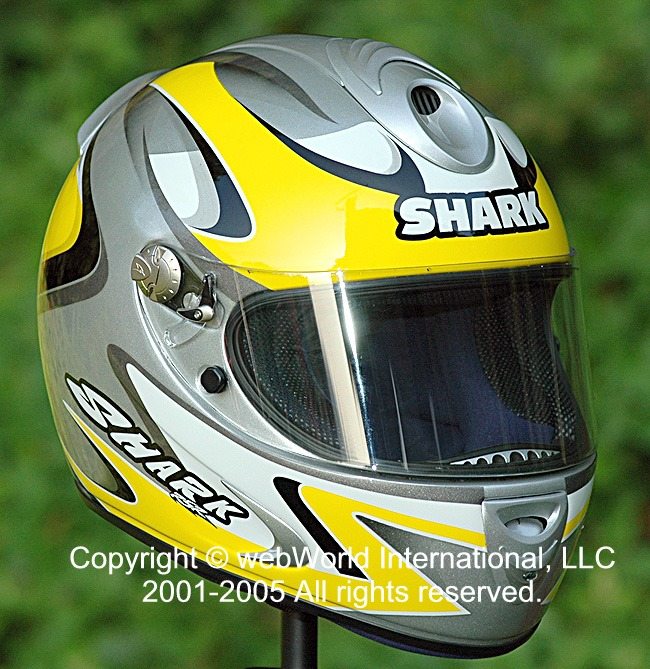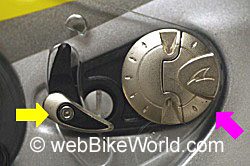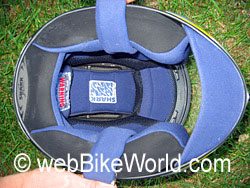Shark Race Helmet
The Shark RSR is very expensive.
It is relatively light at 1601 grams for a size XL.
It is Snell certified and meets the ECE 22-05 and DOT standards.
The face shield is very thick at 3 mm, yet it has outstanding optics.
It also has an infinite adjustment for opening and is also adjustable for the amount of opening and closing force.
The Shark RSR has a very comfortable liner and excellent air flow.
It has a D-ring type chin strap that is also very comfortable.
The helmet is relatively quiet and it includes summer and winter breath guards, tear-offs and under-chin wind blocker.
Here’s a motorcycle helmet trivia question: What to these motorcycle racers have in common?
MotoGP racers Alex Barros, Olivier Jacque and Jeremy McWilliams; World Superbike racers Chris Walker, Regis Laconi, Gregorio Lavilla and Troy Corser; World Supersport racers Stephan Chambon and Karl Muggeridge?
There’s more: Arnaud Vincent and Randy DePuniet in 250cc; Pablo Nieto in 125cc; David Vuillemin in Motocross. I could go on and on.
What do they all have in common?
You’ve probably guessed by now — they all wear Shark motorcycle helmets!
Shark helmets have been very popular with motorcycle racers, but the brand has also been a best seller in Europe for some time.
Shark helmets have recently been introduced in the U.S.A., and we obtained their top-of-the-line model, the RSR, for this review.
Shark is serious about the U.S. market, and they went through the trouble of obtaining a Snell certification for almost their entire helmet line.
Not that a Snell cert is any better or worse than an ECE 22-05 approval, in our opinion, but it does give many U.S. riders a sense of security and it also shows commitment to the U.S. market.
It is said that “racing improves the breed”, and Shark has focused on motorcycle racing as the primary motivator for their designs and technology.
The RSR’s shell is made from a “multi-axial fiber structure”, composed of a composite of carbon fiber, Dyneema, Aramid fibers and epoxy resin.
Dyneema is claimed to be “the world’s strongest fiber” and who are we to argue?
The bottom line is that the Shark RSR is light yet it has enough guts to meet the world’s toughest motorcycle helmet safety standards, as demonstrated by its ECE 22-05, Snell and DOT approvals.
All this technology doesn’t come cheap — the Shark RSR lists at nearly $700.00, which is more than some motorcycle riders will pay for a lifetime of helmets.
Is it worth it? Only you can decide, but we’re going to do something a little different here and start with our conclusion first: the Shark RSR is hereby designated as webBikeWorld’s “Helmet of the Year”!
I know, it’s a bit late in the season, but it’s taken almost a year to find one worthy enough!
The Shark RSR puts it all together in a wonderful package that includes very high quality construction, a supremely comfortable liner, very good air flow, light weight, relative quiet, a large selection of colors and graphics and, of course, the heretofore mentioned safety approvals.
The agreement here at webBikeWorld is unanimous: if we had to own only a single helmet, the Shark RSR would be it.
That’s not to say that it doesn’t have a couple of faults: after all, the perfect helmet doesn’t exist…yet. But read on and we’ll explain.

Where to Buy Shark RSR Helmet
Check Reviews & Prices on Amazon Check Reviews & Prices On RevZillaSee More Motorcycle Helmets, Motorcycle Visor, Motorcycle Intercom
Paint and Graphics
Motorcycle helmet manufacturers use all sorts of acronyms and mumbo-jumbo to describe their helmet shell compositions.
The low end helmets typically use polycarbonate, while the more expensive and/or race helmets use various proprietary blends of exotic fibers.
If a helmet meets the various safety tests, it’s hard for an owner to know if one material will protect any better than the other.
And some helmet manufacturers use high-tech blends to construct their helmet shells and still end up with a heavy helmet, so who knows what’s best?
But the exotic fibers used in the RSR seem to have done their job, because the helmet weighs in at 1601 grams for a size XL (3 lbs., 8-1/2 oz.), which makes it the lightest Snell, DOT and ECE 22-05 approved helmet we’ve found.
Motorcycle helmet manufacturers have told us that helmets meeting the Snell certification are usually heavier than their ECE 22-05 only counterparts. Apparently, there’s a Snell penetration test that isn’t included in ECE 22-05.
To pass the Snell test, the helmet shell usually must be thicker, adding weight. But Shark has managed to pass the test with a minimal weight difference, so their fiber mix must be doing its stuff.
The finish and graphics on the RSR are very good.
Not quite perfect, because there are a few very tiny bumps that can be seen under close inspection under the decals, but the overall impression is one of quality.
The paint and clear coat is very good, not quite as thick as the other ultra-high-end helmet we’ve reviewed, Schuberth’s S1, but no one would no the difference unless they’re compared side-by-side.
Shark offers many different race replicas, so it should be easy to find a color and graphic pattern that tickles your fancy.
The Shark RSR has a few added-on vent trim parts that leave small gaps where they’re mounted to the helmet shell, and we’ve noticed that these gaps seem to attract insects and dirt during a ride.
This makes the helmet harder to clean than others, but the gaps are the only flaw in the overall finish and they don’t seem to have affected the overall integrity of the helmet.
Where to Buy Shark RSR Helmet
Check Reviews & Prices on Amazon Check Reviews & Prices On RevZillaSee More Motorcycle Helmets, Motorcycle Visor, Motorcycle Intercom
Face Shield
The RSR’s visor looks thick because it is. At 3 mm, it’s one of the heftiest used on any motorcycle helmet. It has excellent optical qualities, and it includes an anti-fog coating.
The visor doesn’t use the typical molded-in click stops to hold open the visor at various settings.
The RSR’s visor is infinitely adjustable up and down within its range.
The amount of force that is necessary to raise or lower the visor is adjustable via the hex screw in the center of the comma-shaped “safety lever” on each side (yellow arrow, photo left).
The safety lever also holds the visor in place in the unlikely event of a failure of the visor release mechanism.
The mechanism used for rotation and removal of the visor is unique.
To remove the visor, first turn the safety latch so that it lines up with the slit cut into the visor. Flip open the round visor removal latch (pink arrow, photo left) and give it a 1/4-turn twist, and the visor pops off.
This unique removal mechanism is more complex than other helmets, but it works well and the metal parts seem like they’ll last forever.
The visor removal latch is very stiff, so it’s hard to lift with a fingernail, but a coin will do the trick. We’re not sure if it will loosen up over time; probably not, because the only time it’s used is when the visor needs replacement.
The visor has tear-off posts attached, and Shark includes a few tear-offs in the package.
We really like the visor’s friction locating system, which allows it to be raised and lowered to any location and not just to the half-dozen or so fixed click stops found in other visor systems.
The RSR has a small indent built into the shell under the left hand side of the visor which works as a place to slide in a finger to push open the visor. The thickness of the visor prevents it from twisting when it’s pushed up with one finger.
Ventilation
The RSR has the typical ventilation combination of chin inlet and top inlet with rear exhaust vents. The chin inlet opens with an easy to use slide mechanism; push it up and down to open or close.
The air from this vent flows up on to the back of the visor and on to the rider’s face. It provides a good amount of air flow and the slider has a positive feel.
The top vent is the most distinctive feature of the RSR. It’s a big, it’s round and it has “in-your-face” styling. It probably wouldn’t be as noticeable if it wasn’t emphasized by the various trim pieces that surround it.
A slider on top opens or closes the vent in a positive manner. The vent provides a decent amount of air flow across the rider’s head.
It’s about as much air flowing through the top of a helmet as we’ve experienced; only the OGK FF-3, which is unfortunately no longer available, has better air flow in our opinion (see the wBW review).
The rear exhaust vent is located in back of the spoiler on top of the helmet. A simple on/off switch opens or closes the exhaust, but as with most rear exhaust vents, it’s hard to tell whether it’s working or not. The RSR also has small single vent on each side on the lower part of the shell.
The volume of air flow through the RSR is probably enhanced by its special foam liner.
The liner has deep grooves running longitudinally from front to back, and the top of the fabric helmet liner is designed to “float”, allowing lots of air to run over the top of the rider’s head.
Where to Buy Shark RSR Helmet
Check Reviews & Prices on Amazon Check Reviews & Prices On RevZillaSee More Motorcycle Helmets, Motorcycle Visor, Motorcycle Intercom
 Helmet Fit and Internal Shape
Helmet Fit and Internal Shape
It’s often hard to tell the difference in helmet liner comfort, no matter what the manufacturer’s marketing hype would like you to believe.
Unless the liner is made from a very rough fabric or if it’s thin enough to allow the parts of the shell to be felt, just about any liner will offer acceptable comfort.
But the RSR’s liner is truly different; not only is the fabric very soft, with a feel almost like soft Chamois cloth, but the squishy padding is form-fitting and comfortable.
The RSR will probably fit round shaped heads best. It is designed to have a very snug fit, which is normal for racing helmets.
Our feeling is that the RSR runs at least one size small; i.e., you may want to order one size larger than normal.
I have an “earth” shaped head (see the wBW Motorcycle Helmet FAQ page for more information on helmet fit) and the RSR is one of the most comfortable helmets I’ve tried, with one exception.
The cheek pads cause some discomfort at my temporomandibular joint (jaw joint) after about an hour or so.
Shark has an extensive list of replacement parts for the RSR (available via download in .pdf format on their website), so I plan on ordering a new set of thinner cheek pads, which I’m sure will fix this problem.
But overall, the combination of the squishy padding and comfortable liner makes the RSR feel like it was custom-tailored just for me.
Weight
We’ve addressed this above; make sure you check out the wBW Motorcycle Helmet FAQ page, where you’ll find a chart that compares the weight of some of the motorcycle helmets that we’ve reviewed.
Note that Shark uses two different shell sizes, and the XL and XXL weigh slightly more than the smaller sizes.
Helmet Noise
It may be because of the snug fit, or the form-fitting liner, but our opinion is that the Shark RSR is a relatively quiet helmet for its type.
Note that we always wear correctly fitted earplugs whenever we ride (see the wBW Earplugs and Hearing Protection page for more information) and we always wear a helmet liner, or “do rag”.
Shark includes an under-the-chin wind blocker that helps eliminate some of the low frequency “booming” noises that are typically generated from up under the neck area of the helmet.
We’ve also found that the Windjammer helmet wind blocker (review) can help eliminate much of this type of noise. But overall, the RSR is quieter than other race helmets, and only has a “whooshing” noise that is generated through the large vent openings.
Miscellaneous
Shark includes both summer and winter breath guards that can be attached to the helmet. The summer breath guard is a small piece that slips in behind the vent that opens on to the back of the visor.
The winter breath guard is a large piece of material that snaps in to two holes inside the helmet in the back of the chin guard. A soft metal bar can be bent to form the piece to the rider’s face. Shark also includes a soft helmet bag with the purchase.
The Shark RSR uses the tried-and-true D-ring attachment system. Our opinion is that D-rings are the only way to go; we haven’t found any type of “quick release” system that is as simple and works as well as D-rings.
The RSR’s strap has the same comfortable padding used in the rest of the helmet, and there’s a snap on the strap end to keep it secure.
Conclusion
The Shark RSR doesn’t really break any new ground in helmet design, but its combination of high-quality finish, very comfortable liner, good ventilation and the ease of use for the visor make it hard to beat.
The RSR stands out from all of the helmets we’ve tried this year, so we’re awarding it with our informal webBikeWorld “Motorcycle Helmet of the Year” award.
If we had to choose only a single helmet to wear every day, this would be it.
However, its price means that it’s not for everyone. Is it twice as good as a $300.00 helmet? Probably not.
| wBW Review: Shark RSR Helmet | |
|---|---|
| Manufacturer: Shark Helmets | List Price (2004): $592.99-$699.99 |
| Colors: Many solids, graphics and replicas. | Made In: Thailand |
| Review Date: October 2004 | |
Where to Buy Shark RSR Helmet
Check Reviews & Prices on Amazon Check Reviews & Prices On RevZillaSee More Motorcycle Helmets, Motorcycle Visor, Motorcycle Intercom
Owner Comments and Feedback
See details on submitting comments.



 Helmet Fit and Internal Shape
Helmet Fit and Internal Shape
No Comment